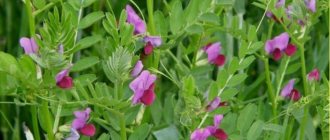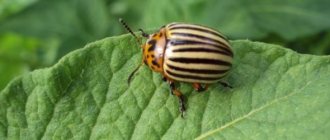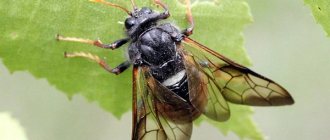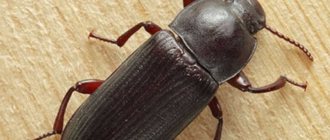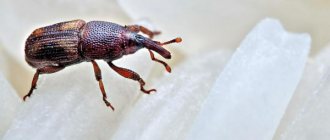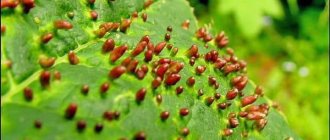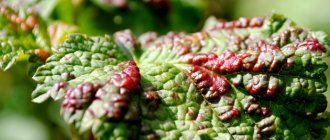Appearance
When the first greenery appears on the trees, various garden pests also appear. It is during this period, having safely overwintered in the ground, that the female May beetle or beetle begins to lay eggs. She lays them very deep - almost a meter deep, which makes it impossible to detect the masonry. Immediately after this, the females die, and after 20 days, larvae begin to hatch from a large number of eggs (on average 100 pieces). At a young age they are almost harmless, but as they mature they become formidable pests for garden and vegetable crops.
On a note!
Externally, the cockchafer larva looks like a thick white-yellow caterpillar with spots and rings on its sides. They are no larger in size than small worms, but already in the 2nd year they are 5 cm long, and then grow to 6.5-7 cm.
Their characteristic feature is a ring-shaped C-shape, but as they develop they increase in size, and a brown head becomes noticeable, on which there are no eyes (they are not needed underground). They have 3 pairs of legs covered with hair and a gnawing mouth with brown jaws, as seen in the photo of the cockchafer larva.
The main diet of beetle larvae consists of roots of garden crops. Through the thin skin of the abdomen you can see where food is digested. As the larva increases in size, it becomes more voracious and is able to eat larger plant roots.
On a note!
Underground they are able to move sometimes up to 100 m in length. As they develop, the larvae begin to crawl upward and try to get to the surface of the earth.
May beetle larvae
Diet of cockchafer larvae
The main damage to plants is caused by beetleworm larvae. The adult beetle eats the upper part of the plant. The larva, in the form of a thick caterpillar with a large number of movable legs, eats everything that comes along its path. And this:
- Roots of strawberries, wild strawberries. The first sign of its work is wilting and stunted growth of the berry bush. The sooner this plant is discovered, dug up, and removed, the better. The main thing is to dig deep, find the larvae, and destroy them.
- Roots of lawn grasses, humus, and certain types of weeds.
- Vegetable seedlings.
- Young shoots, root crops of carrots, beets, potatoes.
- Trunks of young trees and shrubs.
How long does the larva grow and the damage it causes?
The development process of the cockchafer larva is very long - it lives underground for about 4 years, then pupates at a depth of 30-50 cm and turns into a beetle. This is the final stage of development, which usually occurs at the end of summer or the first month of autumn.
Young cockchafers spend the winter in the ground, and when spring comes, they come out again to mate and have offspring. The number of beetles is favorably influenced by good weather. Their active life continues for several years.
Any soil is suitable for the larva to live, but it often gives preference to places where fresh manure has been applied. Large individuals (4 to 7 cm long, which exceeds the size of the cockchafer itself) can gnaw potato tubers and harm strawberry and berry bushes. Of the trees, the larvae prefer to live under apple trees, pears and apricots. After damage to the root system, many leaves become limp and dry out, and the plant often dies.
Interesting!
According to biologists, a 3-year-old cockchafer larva is capable of eating all the roots of a young tree within a day.
Older larvae are capable of causing enormous damage to the crop, damaging the roots of vegetable and garden plantings. Therefore, it is so important to get rid of the cockchafer larvae in time before they destroy the future harvest.
Studying the goal
The breeding season of the cockchafer begins in May, and after mating, the female chafers burrow into the ground and lay eggs.
Life cycle of the cockchafer
No later than a month and a half later, large white larvae appear, which are easily recognized by their curled position. They live for 3-4 years and before the onset of the last winter period in the development cycle, they turn into pupae, from which an adult insect emerges at the end of next summer. Well, thanks to its impressive size, peaceful but annoying disposition, characteristic brown-brown color and insatiable appetite, it is almost impossible to confuse it with another species.
Male and female cockchafer
The larvae of the cockchafer love strawberry roots, as well as the root systems of a number of vegetable crops - corn, potatoes, cabbage, etc. No less attractive to them are the roots of trees, especially fruit trees - cherries, apples and plums, as well as various shrubs, for example, gooseberries and currants.
The cockchafer does not lay eggs in turf, rocky or heavy soils. The age of the larvae can be determined by their size and behavior. Thus, in the first year of life, the width of their head capsule is about 2.5 mm, and they themselves feed mainly on humus and small roots of various vegetation. In the second year, the larva’s head grows approximately twice as large – up to 4 mm, and in the third year – another one and a half times (6-6.5 mm). In August and early September, the caterpillars hide from the cold to a depth of 1-1.5 m, and in the spring they rise again almost to the very surface of the soil - closer to the food. Three-year-old larvae are the most voracious - each of them alone is capable of destroying the root system of a young pine or spruce in a day.
Movement of May larvae in the soil during development
Infestations of the cockchafer, which occur once every 7-10 years, are a real disaster for everyone who has their own garden. If your site is located not far from a forest or oak grove, as well as next to areas already favored by it, sooner or later this insect will come to you.
Fighting larvae
In order to determine effective measures to combat chafer larvae, one should not only know their development process, but also their taste preferences. The voracious creatures consume not only leaves, like adult adults, but also roots, flowers and other parts of plants.
From fruit trees and shrubs, they love to gnaw on the roots and green mass of plums, cherries, sea buckthorn and black currants. May beetle larvae in the garden feast on strawberry roots and even eat the roots of young lawn grass.
The fight against cockchafer larvae should be carried out comprehensively, using various methods, especially when there are large numbers of them.
Basic methods:
- folk remedies;
- chemical and biological remedies against the cockchafer and its larvae.
May beetle eggs and larvae
How to detect?
Where to find the larva of the cockchafer? The habitat of both the beetles themselves and the larvae is distributed along rivers and forests, in coastal valleys, meadows and agricultural areas. The most favorable environment for them is moist and warm soil , rich in nutrients (humus) and which is easy to loosen.
In the summer, between the rows of potato and corn plantings, the larvae just begin to hatch from eggs and are found in the soil at a shallow depth (less than 20 cm). If the season turns out to be hot, with rare rains, then the larvae of the cockchafer go underground more than half a meter.
Another favorite habitat for larvae is thickets of weeds and wild shrubs, places under the roots of various trees, as well as rotten old stumps.
Folk methods of struggle
On warm days, the larvae rise higher to the surface; they can be easily detected by deep digging of the soil (about 20 cm deep) and destroyed. The most famous old-fashioned method involves manually collecting them when digging the ground, for which they are collected in a separate container and then burned.
On a note!
Khrushchev larvae are often found in fallen leaves, which must be collected in time.
Various folk recipes are also used in wrestling:
- make a chlorine solution (100 g per 0.5 liters of water) and treat the ground around the infected bush;
- leave onion peel (1/3 of a bucket of water) for 5 days, then dilute in a 1:1 ratio, mix well and use for regular watering during plant growth;
- a solution with potassium permanganate is used to protect potato plantings; they need to be sprayed on the lower leaves;
- add 15 ml of ammonia to a bucket of water and use it to water the beds with berry bushes.
Also, to water the soil and destroy cockchafer larvae in the ground, the following infusions and decoctions of herbs are used:
- tincture of wormwood (stems and leaves are taken) is prepared from 300 g of dry grass, 200 g of wood ash per bucket of water;
- take 1 kg of walnut leaves, pour 10 liters of boiling water and leave for a week;
- decoction of poplar leaves (leave for 3 days);
- tincture of sunflower flowers and petals;
- infusion of dried acacia bark (proportions 1:10).
On a note!
Many gardeners suggest fighting beetleworm and its larvae in the garden using traps. For catching, plastic bottles with water are placed in which insect bait is placed. Once they get into it, the beetles will no longer be able to get out.
How to deal with the cockchafer
It is recommended to apply medications against the cockchafer early in the morning or in the evening. Do not process in direct sunlight. In dry weather, with insufficient soil moisture, after treatment the soil is watered abundantly.
Popular protection against cockchafers using folk methods:
- mechanical digging of soil using a shovel bayonet;
- sodding (planting green manure);
- treatment with infusion of onion and garlic;
- sowing lupine.
Advice! For prevention, plant garlic in the habitats of beetles and their offspring. The smell repels insects.
A remedy with ammonia tested in the garden helps a lot. Add 100 g of table salt and 2 tablespoons of alcohol to a bucket of water. They water the soil during the flowering period of potatoes and for preventive purposes.
On strawberries and raspberries, for preventative purposes in the spring, a solution of water and ammonia (10 liters of water and 20 ml of ammonia) is spilled between the rows. Treatment with insecticides and traditional methods are also effective: infusions of onion peels are thoroughly poured onto each bush.
Advice! Traps are prepared for adult beetles. Containers with kerosene are placed in a well-lit area at night.
To reduce the population of insects, trees and bushes are manually shaken off in the evening and burned. Khrushchi are afraid of the smell of elderberries and flowering cruciferous vegetables: turnips, turnips. By planting the area with these plants, you can be sure that pests will not fly into this area.
How to get rid of cockchafer larvae
The fight against cockchafer larvae involves an integrated approach. From autumn and throughout the growing season, it is necessary to carefully dig and deeply loosen the soil. Eggs, larvae and cocoons, subjected to regular mechanical stress, are injured and die.
You can get rid of larvae with a guarantee using chemicals. There are many remedies for cockchafer larvae. Among the most popular insecticides are Bazudin, Zemlin, Aktara. The biological agent Nemabakt guarantees the destruction of larvae in the ground within a few days without harm to health and plantings. A popular effective remedy offered by the industry, Antikhrushch is characterized as an effective way to fight in a short time.
Sow the affected areas with lupine. Weeds do not grow in such an area. The larvae in the ground, forced to feed on lupine roots, die. The soil is treated with chlorine solution: 0.5 l. add 100 g of chlorine to water. Water as carefully as possible, between rows, so as not to damage the roots of the plants.
Ammonia for larvae is effective when used regularly. Places where traces of damage are noticed are generously shed with ammonia solution. The procedure is carried out with the onset of warm weather and just before the onset of frost, trying to avoid getting the composition on the plants.
It is effective to use iodine (add 10-15 drops of iodine to 10 liters of water), pour the affected areas with this solution throughout the summer. After watering, the soil must be deeply loosened. In the spring, make deep, up to 40-50 cm, furrows in the beds and water them with a solution of Karbofos or Decis. The larvae die within a few days.
Advice! The use of preparations containing chlorine for soil treatment is effective. This is how the familiar Whiteness is used in practice.
You can fight without using aggressive chemicals, using folk remedies. For this purpose, garlic and onion peels are traditionally used for infusion. A concentrated solution is prepared in a bucket and kept for 3-5 days. Dilute with water 1:1 and add 1 liter. under each bush.
You can remove cockchafer larvae by burying rotten fish or herring in the ground, not far from the affected areas.
An effective method has been tested in practice: manure traps. In the fall, deep holes, up to 1 m deep, are dug in the garden and filled with fresh manure. The larvae will definitely choose this cozy place for wintering. All that remains is to dig everything up in the spring and destroy it.
If gardeners do not want to poison pests with chemicals, they are collected manually by digging. This method does not guarantee results.
It is not recommended to leave old stumps and thickets of herbaceous plants at the dacha. By uprooting them, you can find entire colonies of larvae. Among the effective preparations, Prestige is noted; it is used to treat the roots of seedlings and potato tubers before planting.
To combat larvae, ammonia is used in the soil under raspberries and roses: 10 ml per 10 liters of water. The soil is watered abundantly twice during the spring-summer period.
You can process strawberries, a special treat for the larvae, in any suitable way. If folk remedies do not help, it is worth transplanting it to another area, having previously treated the soil and making sure that there are no pests there. Dig up the previous place and sprinkle with bleach.
In areas where pest colonies have been observed, the soil is cultivated especially carefully. If it is possible not to sow the area next year, it is better to carry out complex treatment for preventive purposes.
Chemicals
The most effective, but unsafe method of dealing with cockchafer larvae is the use of special chemicals. These preparations are used to treat the root system of seedlings and other planting material (bulbs, tubers, etc.). Their action is based on the penetration of poison into the intestines of insects through the underground parts of plants.
Agents against larvae
Preparations for cockchafer larvae and their effect:
- Antichrusch is a concentrated suspension containing imidacloprid and bifenthrin, which, once ingested by pests, has a negative effect on their nervous system, and is used when watering the soil around plants;
- Zemlin - acts through the digestion and intestines of insects and larvae with the help of the active substance diazinon;
- Aktara - the prepared solution is poured under the roots of plants to destroy the larvae;
- Pochin - added to the ground when sowing garden crops to poison underground pests;
- Nurell-D - the solution must be poured under the root, it is used for adult plants (shrubs and trees), penetrating with moisture into the root system, and then the poison enters the body of the larvae with food;
- Bazudin - added to the soil during planting, the granules contain diazinon, kills pests by contact-intestinal method after the poison enters through the roots and green parts of plants; however, poison should not be allowed to enter water bodies;
- Vallar - granules containing diazinon, dissolved in water intended for irrigation; the toxic substance penetrates the roots and cells of the plant and, after being eaten by the larvae, poisons them; You can also make a solution and dip the roots of the plants before planting.
If you take precautions and follow the recommendations specified in the instructions, all of the listed chemicals are not dangerous for plants, but they allow you to get rid of larvae living underground in your dacha or garden.
Basic description of the pest
May lily of the valley composition, properties, benefits and harms, use and contraindications
May beetles, also known as May beetles, are insects of the order Coleoptera, family Lamelidae, type - arthropods, inhabit Europe and Asia. In some years, they caused enormous damage to agricultural activities. Thanks to the widespread use of pesticides, their population has decreased significantly, and in some areas they have completely disappeared. In the 1980s, the use of a number of chemicals was banned, and their number began to increase. The larva of the cockchafer, a photo of which you will see below, causes enormous damage to plants. Read on for ways to combat the pest.
This insect is quite large in size - up to 31.5 mm. The elongated oval or broad oval body is quite protruding forward, black or red-brown, the elytra are mainly red-brown or yellow-brown in color. The head and pronotum sometimes have a faint greenish tint. The sides of the ventral part have white triangular spots of small dense hairs, mostly large and clear, rarely small and blurred.
The body has dense small or shallow punctures and small adjacent hairs or hair-like scales of a whitish, yellowish or grayish color. The hairs and scales are of medium density (in young individuals that have just become beetles), and are very dense, hiding the main background. On the head and pronotum there are usually the longest protruding hairs, mainly collected in longitudinal stripes. The underwings also often contain the sparse, longest, bristling hairs. The extreme segment of the maxillary palps is elongated, pointed at the apex, slightly curved, and has an indentation at the top.
The antennae have ten segments, the third palp is elongated, the male has a large, significantly curved club, which consists of 7 identical plates, the female has 6. Large, semi-oval, very smooth, shiny scutellum, sometimes with relatively dense punctures with small hairs or scales . The elytra are oblong-oval, with 5 narrow ribs, the distance between them is densely dotted and wrinkled. The posterior section of the abdomen is large, inclined, triangular or blunt in shape, elongated in the form of a process. In females the process is always shorter, in males it is more developed and elongated.
The chest is covered with thick and long yellow hairs. The abdomen is covered with both small, non-protruding hairs and scales, and bristling long, frequent or sparse hairs, sometimes they are absent. There are also hairs on the legs, longer on the thighs. On the outside of the fore tibia there are two, rarely three, teeth.
It will be useful to read:
Ways to destroy spider mites There are many different insects that harm garden and vegetable crops. To destroy some...
Biological products
Proven biological products are also available for sale in specialized stores, which are completely safe for plants and people, but allow you to get rid of beetles and their larvae in the garden.
Nemabakt for the fight against Khrushchev
The drug Nemabact was created using nematode worms, which, after being introduced into the soil, actively attack the larvae of the cockchafer. After just 1-3 days, their number will become much smaller, and then it will allow you to get rid of them forever. Worms introduced into the soil maintain balance for 2 years.
It is used when watering the soil (morning and evening), it must first be diluted in a ratio of 1:100, the optimal air temperature should be from +10 to +26°C with high humidity.
Nematodes are stored in a special biosoil called Bioshield. 5 liters of prepared soil with nematodes are designed to treat 15 square meters. m of land in the garden. You can buy such a drug only in specialized stores and must store it only under certain conditions specified in the instructions.
On a note!
Scientists have discovered an interesting feature of beetles - they cannot tolerate high levels of nitrogen in the soil. Therefore, for prevention purposes, you can use planting white clover in the garden and in the garden in tree trunks. In its root system there are special bacteria that can absorb nitrogen from the air and then accumulate it in the ground. Thus, the concentration of nitrogen in the soil increases.
Throw in a big feast
Like many insects, the eastern May beetle lives through several stages of development and, being in each of them, causes damage to the garden on a “particularly large scale.” Of course, a lot depends on the number of insects flying into the garden. Adult females and males, having settled in the garden, begin to intensively feed on juicy and fresh leaves of rosehip, white and yellow acacia, elderberry, Tatarian honeysuckle, and grapes. The voracious insects eat even seemingly inedible-tasting “dishes” such as larch needles and young pine growth – “candle” inflorescences. The May beetle finds its dessert in the orchard, where it eats delicate flowers and plant ovaries. By the way, the May beetle is classified as a polyphagous pest, that is, one that eats everything almost indiscriminately. He will not like the rare plant.
But this pest comes to you not only to live at your expense and cause damage to your crops. It also begins to multiply on your land. By the way, females will find one of the safest places in your garden for their offspring, which is difficult to detect. In May, they burrow into the ground to a depth of 30 cm and lay up to 70 eggs measuring about 2 mm. In July, larvae emerge from the eggs and eagerly attack the thin roots of garden strawberries. Moreover, this voracious offspring lives in the ground not just for one year, but for several years in a row, overwintering in the soil and continuing to feed on roots in spring and summer. The larvae of the first year of life feed on the tender and thin young roots of garden strawberries and vegetable crops, but as they grow up, they move to larger roots. It is clear that plants begin to wither and die for no apparent reason. Only in the fourth year of life do the larvae move to a new stage - imago, becoming adult beetles capable of reproduction.
Eastern May Khrushchev. Photo: Shutterstock.com
Prevention measures
To prevent the appearance of the cockchafer and its larvae in your garden plot, the following preventive measures should be taken:
- regularly dig the soil deeply and then mulch it;
- in the spring months, a layer of crushed tree bark, straw or shavings should be laid on top of the soil - they will prevent female cockchafers from laying eggs;
- make grooves between crops in the garden, spilling them with karbofos solution;
- plant flowers of the cruciferous family, marigolds and lupins near plants, the smell of which always repels beetles and beetles;
- planting fodder turnips around the perimeter of the bed, burying cabbage leaves and green mustard shoots are folk techniques that help repel beetles;
- those who breed poultry can use the found larvae for feeding.
The cockchafer is one of the most dangerous pests of gardens and vegetable gardens. Only an integrated approach will help get rid of adult beetles and their larvae, which involves the use of both chemicals for treating garden crops and traditional methods of controlling and preventing the proliferation of pests.
Interesting facts about the cockchafer
- An interesting feature of cockchafers is the fact that insects fly contrary to all the laws of aerodynamics: these beetles have too little lift coefficient, and, according to experts, they should not fly at all!
- The cockchafer is an extremely purposeful insect, and it is almost impossible to confuse it. Having set its goal at a certain hill, the beetle will fly in a given direction no matter what. You can catch the beetle and release it in another place, try to disorient it using a chemical or physical method, but once in the wild, the cockchafer will still return to the set course and reach its goal.
- Possessing an exceptional appetite, the May beetle larva of the 3rd year of life is capable of completely destroying the roots of a two-year-old pine tree in one day.
- In Andersen's world-famous fairy tale “Thumbelina,” the cockchafer is one of the contenders for the hand and heart of the main character.
Photo by: jp hamon
- Next publication Spider wasp (Argiope Brünnich)
- Previous publication Lemur

